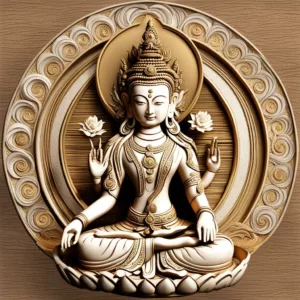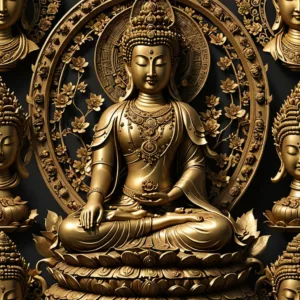8-fold path of Buddha
Right Concentration, Right Meditation, or samadhi means attaining a one-pointed focus and applying it to objects of wisdom, such as selflessness, emptiness, or tatagathagharba.
8-fold Path of Buddha
| PILLAR | SANSKRIT | MEANING |
|---|---|---|
| Noble Eightfold Path | ariya aṭṭhaṅgika magga | |
| HINAYANA | ||
| Right View | samyak-saṃkalpa | Stance of not-self, karmic cause and effect |
| Right Motivation, Resolve, Aspiration | samyak-saṃkalpa | Desire to liberate oneself from suffering, not engage in the kleshas |
| Right Speech | samyag-vāc | No lying, gossiping, slander, or harsh words |
| Right Conduct | samyak-karmānta | Not killing, stealing, sexual misconduct, or avarice |
| Right Livelihood | samyag-ājīva | Not selling arms, intoxicants, people, or sexual acts |
| Right Effort | samyag-vyāyāma | Limiting desires for pleasure. Simplicity of life, maintaining wholesome outlook of mind. |
| Right Mindfulness | Satipatthana | Unflagging focus on cutting karmic actions and seeing not-self |
| Right Meditation | samyak-samādhi | Shamatha, or stable concentration leading to vipassana, insight into not-self |
| MAHAYANA | ||
| Right View | samyak-saṃkalpa | View of emptiness |
| Right Motivation | samyak-saṃkalpa | Liberation of all beings from suffering, compassion |
| Right Speech | samyag-vāc | Helpful speech, guiding beings to the dharma |
| Right Conduct | samyak-karmānta | Exchanging oneself for others |
| Right Livelihood | samyag-ājīva | Actively helping, never harming. Seeing the illusory nature of life. |
| Right Effort | samyag-vyāyāma | Unceasing effort for the benefit of beings |
| Right Mindfulness | Satipatthana | Bare attention on emptiness |
| Right Meditation | samyak-samādhi | Equipoise seeing emptiness directly |
| VAJRAYANA | ||
| Right View | samyak-saṃkalpa | All beings are enlightened, Buddha fields are all-pervasive |
| Right Motivation | samyak-saṃkalpa | Seeing all beings as Buddha |
| Right Speech | samyag-vāc | All sound is mantra |
| Right Conduct | samyak-karmānta | Luminous light emanating and gathering |
| Right Livelihood | samyag-ājīva | 4 karmas of Buddha activity |
| Right Effort | samyag-vyāyāma | Maintaining samaya, non-effort |
| Right Mindfulness | Satipatthana | All phenomena are pure by nature |
| Right Meditation | samyak-samādhi | Deity, sugatagharba, mahamudra, trekcho, thogal |
Table of Contents
Right Concentration Buddhism

Right Concentration, an integral component of the Noble Eightfold Path, holds a central place in Buddhist teachings as a transformative practice leading to meditative absorption and profound insights.
Also known as Right Samadhi, this aspect of the path encompasses the development of focused, one-pointed attention that culminates in meditative absorption or union. Right Concentration is intricately linked with the cultivation of mindfulness, ethical conduct, and wisdom, providing practitioners with a direct path to liberation from suffering.
Right Concentration of the Eightfold Path
As the eighth factor in the Eightfold Path, Right Concentration harmonizes with the preceding seven components, creating a comprehensive framework for ethical and meditative living. Right View lays the foundation by offering a clear understanding of the nature of existence, while Right Intention guides individuals toward wholesome motivations. Right Speech, Right Action, and Right Livelihood emphasize ethical conduct, creating a conducive environment for the practice of Right Concentration. Right Effort and Right Mindfulness, the preceding factors, prepare the mind for concentrated absorption by cultivating mindfulness and eliminating unwholesome mental states.
Right Concentration Example
To illustrate Right Concentration, consider the example of mindfulness meditation. In this practice:
- Right View: Practitioners recognize the impermanence of sensations, thoughts, and emotions, aligning with the understanding that clinging to the transient leads to suffering.
- Right Intention: The intention behind the practice is to cultivate a focused and equanimous mind, fostering inner peace and wisdom.
- Right Speech, Right Action, Right Livelihood: Ethical conduct is maintained during the meditation, ensuring that the practice is aligned with the principles of non-harming and compassion.
- Right Effort and Right Mindfulness: Practitioners actively engage in the effort to sustain attention on the present moment, cultivating mindfulness of breath, bodily sensations, or a chosen point of focus.
- Right Concentration (Samadhi): As mindfulness deepens, concentration becomes more refined, leading to states of meditative absorption where the mind unifies and becomes absorbed in the chosen object or focus.
This example demonstrates how Right Concentration synergizes with the other aspects of the Eightfold Path, creating a holistic approach to meditation that integrates ethics, mindfulness, and wisdom.
Right Meditation of Hinayana
In Hinayana, or Theravada Buddhism, Right Concentration is primarily associated with the development of meditative absorption known as Jhana. Jhana meditation involves the progressive refinement of concentration through the absorption of the mind into deeper states. Practitioners cultivate intense focus on a chosen object, such as the breath, and gradually enter successive stages of absorption. Each Jhana corresponds to a higher level of concentration and tranquility.
Hinayana meditation aims at achieving individual liberation by transcending attachment and aversion through deep concentration. The meditator progressively moves through the Jhanic states, culminating in a state of profound equanimity. This concentrated absorption aligns with the Hinayana goal of attaining personal enlightenment and liberation from the cycle of birth and death.
How to meditate like a yogi
and enter profound samadhi
Right Meditation of Mahayana
In Mahayana Buddhism, Right Concentration extends beyond individual liberation to encompass the Bodhisattva path—the altruistic aspiration to attain Buddhahood for the benefit of all sentient beings. Right Concentration, in the Mahayana context, involves the development of meditative absorption alongside the cultivation of compassion and wisdom.
Mahayana meditation emphasizes the fusion of meditative absorption with the understanding of emptiness (Shunyata). The practitioner engages in practices like Shamatha (calm abiding) and Vipassana (insight meditation), using concentration as a tool to deepen insight into the nature of reality. The ultimate goal is not only personal liberation but the enlightenment of all beings. Right Concentration in Mahayana becomes a harmonious blend of meditative absorption, compassionate motivation, and profound wisdom.
Right Meditation of Vajrayana
Vajrayana Buddhism, with its esoteric practices and skillful methods, integrates Right Concentration into a transformative path that leverages the practitioner’s subtle energies. Tantric practices within Vajrayana involve the use of visualization, mantra recitation, and deity yoga to attain meditative absorption. These practices are designed to expedite the path to enlightenment by harnessing the practitioner’s innate wisdom and realizing the union of bliss and emptiness.
Vajrayana practitioners engage in intricate visualizations of deities, mandalas, and energy channels, using concentration as a means to awaken dormant potentials within the mind. The esoteric rituals and symbolic practices aim to facilitate a direct experience of the true nature of mind. Right Concentration in Vajrayana transcends traditional boundaries, incorporating profound and transformative methods to expedite the practitioner’s journey toward enlightenment.



Dhyana and Jhana Meditation
Dhyana, often translated as “meditative absorption” or “deep contemplation,” is a term used in various Buddhist traditions to denote states of concentrated meditation. In Hinayana, particularly within Theravada Buddhism, the practice of Jhana meditation is a form of Dhyana. Jhana meditation involves progressive levels of concentration, leading to states of deep absorption where the mind becomes singularly focused on the chosen object.
The term “Jhana” is often associated with absorption states ranging from the initial stages of focused attention to profound tranquility and equanimity. The practice of Jhana aligns with the goal of developing profound concentration, leading to liberation from suffering in the Theravada tradition.
In Mahayana and Vajrayana, the term Dhyana is used more broadly to refer to meditative states that integrate concentration, insight, and the cultivation of wisdom. These traditions incorporate various forms of Dhyana into their practices, emphasizing the inseparability of concentration and insight on the path to enlightenment.
Conclusion
Right Concentration in Buddhism is a transformative practice that leads practitioners to meditative absorption, equanimity, and profound wisdom. Whether pursued in the context of Hinayana, Mahayana, or Vajrayana, Right Concentration synergizes with other components of the Eightfold Path, creating a holistic approach to ethical living and spiritual development. The diverse methods within each tradition showcase the adaptability of Right Concentration, offering practitioners a rich tapestry of techniques to deepen their meditative experiences and insight into the nature of reality. As individuals cultivate focused and absorbed states of mind, they embark on a journey that leads to profound understanding, liberation from suffering, and, ultimately, enlightenment.

May all beings be happy
May all beings be peaceful
May all beings be safe
May all beings awaken to the light of their true nature
May all beings be free







